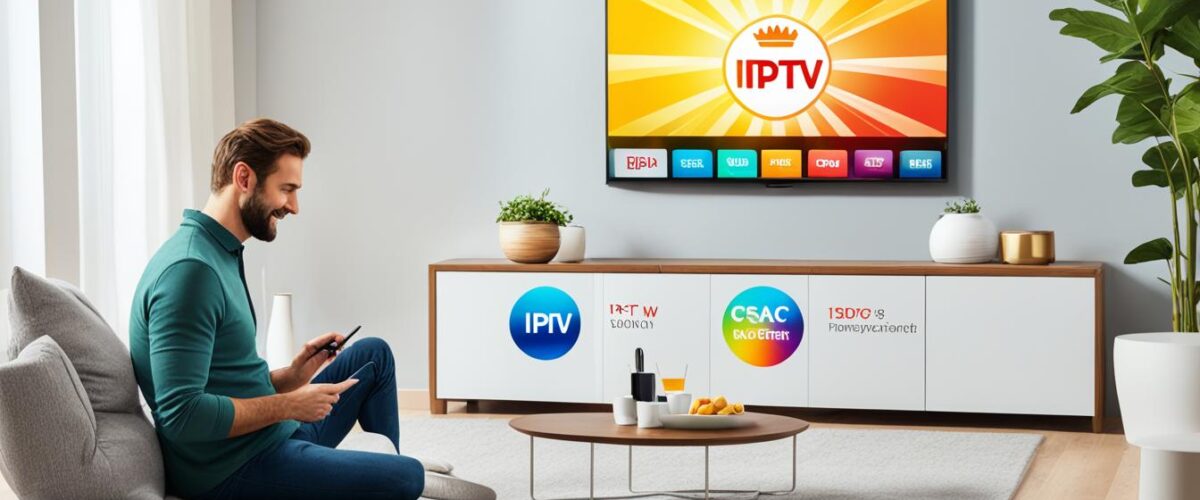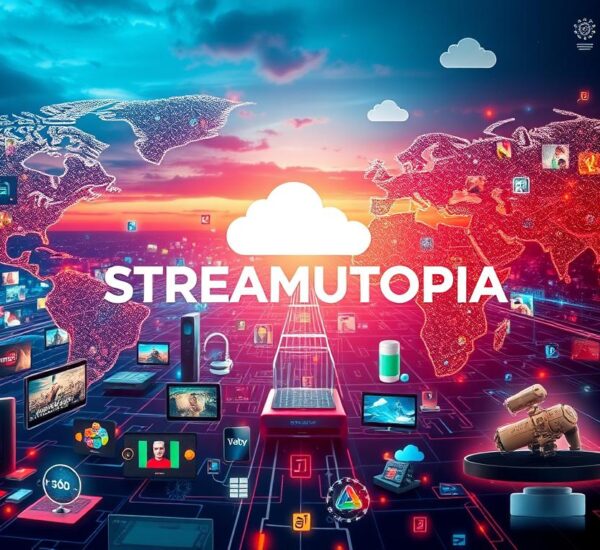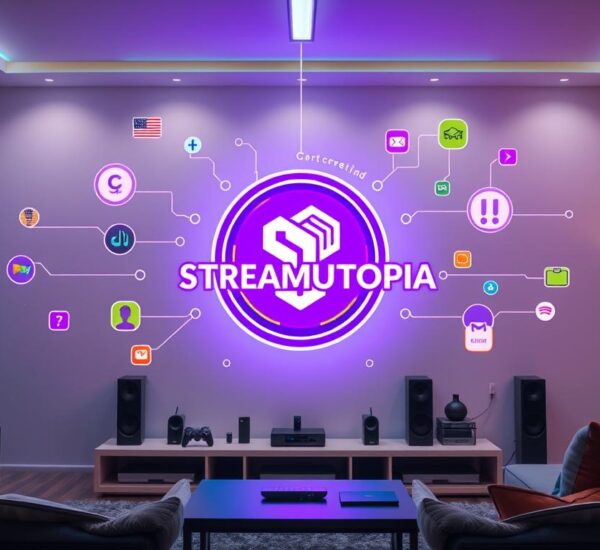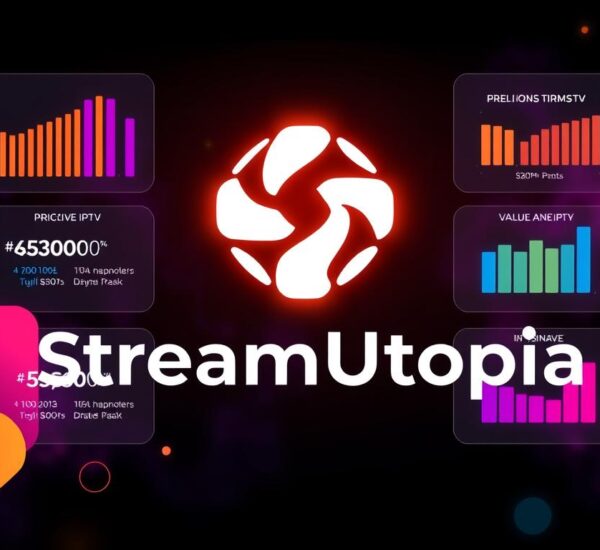Imagine your TV not just streaming shows but also bringing you into the action. IPTV is changing how we watch TV by blending internet and TV content together. It lets you watch live TV, on-demand videos, and more through the internet1. With IPTV, you get to choose what you watch and pick from many channels, making it a game-changer for viewers2.
Key Takeaways
- IPTV offers a “pay-as-you-watch” model, promoting affordability and personalization.
- It enables the blurred lines between traditional TV and internet content, creating a more dynamic experience.
- Quick access to multimedia content enhances overall viewer engagement.
- IPTV infrastructure relies on controlled networks, optimizing content accessibility and storage.
- Future prospects in IPTV suggest advancements in both gaming and news broadcasting.
What is IPTV?
IPTV stands for Internet Protocol Television. It delivers TV content over the internet, unlike old systems that used satellite or cable. This method lets viewers stream shows and movies directly online. It makes watching TV more flexible, allowing users to enjoy content in real-time.
The IPTV definition covers a wide range of services. These services come from many providers, offering live TV and a huge library of films and media. IPTV uses multicast and unicast to send content efficiently. This means viewers can watch live shows or pick shows to watch later on devices like smart TVs or phones. It supports both HD and UHD quality, meeting the demand for better viewing experiences.
Big names like Netflix, Google, and Apple offer IPTV services. Also, companies like Apollo Group TV and Roku provide specialized IPTV. This service includes features like time-shifted TV and video on demand. These options meet the changing tastes of today’s viewers. IPTV is a cheaper option than traditional cable, offering more content without losing quality or user experience34.
Understanding the Evolution of Television
The evolution of television has seen big changes, starting with early broadcast tech and ending with IPTV. This television technology development moved from analog to digital signals. This change improved the quality of what we see and hear.
Television began in the early 1900s with big steps like color broadcasts, cable TV, and satellite TV. The history of IPTV marks a key change. It moved from old ways of delivering shows to using the internet, offering live streaming and on-demand services.
Now, thanks to new tech, viewers can watch shows on many devices at once5. This has changed how we watch TV, making it easier for people all over the world to enjoy different kinds of shows.
IPTV has also made it easier for new producers and small channels to share their work. This has led to new ways for businesses to make money, based on what viewers like and can afford.
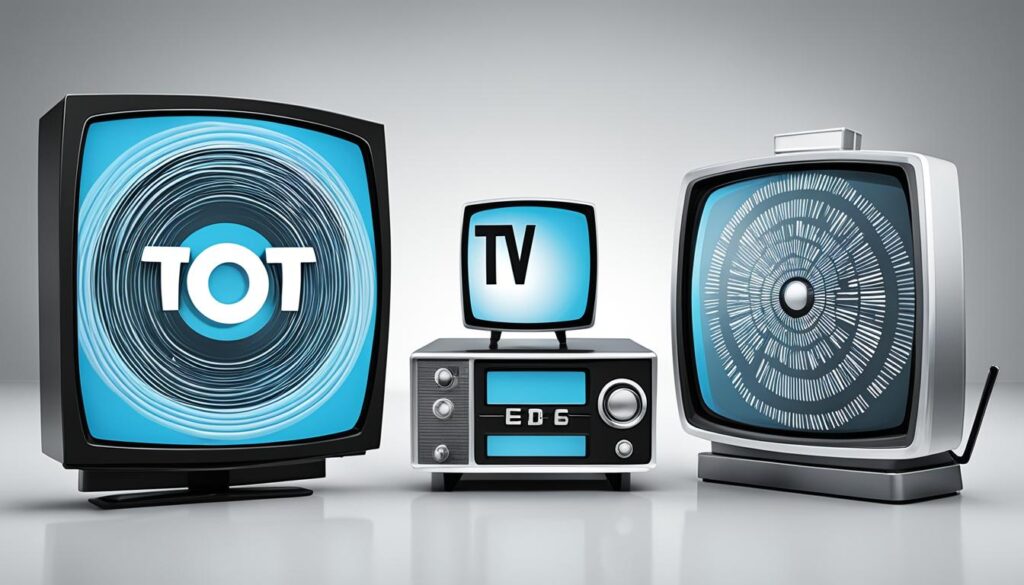
However, IPTV has its challenges, like needing a strong internet connection for good quality streaming5. Still, it offers big chances to make watching TV better. Issues like getting rights to shows and keeping them safe are important as IPTV grows and changes.
How IPTV Enhances Your TV Experience with Interactive Features
IPTV has changed TV by adding many interactive features. These features make watching TV better. Now, users can pick what they want to watch and enjoy lots of on-demand content.
Personalized Viewing Options
IPTV lets you pick your favorite channels and get content that fits your taste. This means you can easily find your top shows and movies. IPTV services focus on what you like, which is key in today’s world with so much to choose from6.
With IPTV, you can change your subscription plans easily without being tied down for a long time7.
On-Demand Content
On-demand content lets you watch what you want, when you want. IPTV gives you this freedom, making your viewing more comfortable. It also offers advanced controls like electronic program guides and DVR systems, giving you more power over your TV time7.
As people want more variety and less ads, IPTV is growing fast, by 30% to 35% each year worldwide8.
The Technology Behind IPTV
IPTV technology changes how we watch TV by using the Internet Protocol infrastructure. It lets users watch live and on-demand shows over IP networks. You can stream live TV, movies, and videos with an internet connection, skipping traditional cable or satellite subscriptions9. IPTV works on devices like TVs, computers, smartphones, and tablets9.
The idea of IPTV started in the early 1990s with early patents. This marked the start of TV over the internet10. Over time, video compression tech like MPEG-2, MPEG-4, and H.264 made streaming quality better without using too much internet10. Fast internet is key for IPTV, helping to deliver videos smoothly and reduce buffering10.
Set-top boxes (STBs) are key for IPTV, decoding and decrypting TV and VOD streams for your TV. They connect to the internet and get content from various sources, like live shows or recorded videos9. Hybrid IPTV is becoming popular, combining traditional TV with IP-based services for a better experience11. Now, IPTV providers are offering 4K and HDR content, showing a move towards better quality viewing10.
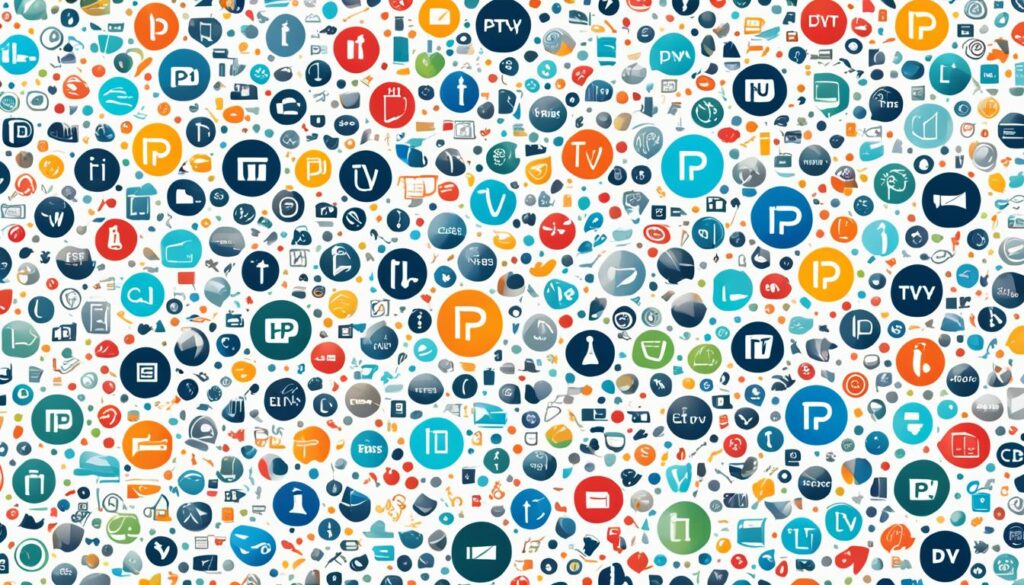
IPTV Benefits for the Modern Viewer
IPTV is becoming more popular with viewers because it’s cheaper than traditional cable. People can pick from different pricing options, which can save a lot of money. In fact, IPTV is growing fast, with a 30% to 35% increase in demand each year worldwide8.
Cost Efficiency Compared to Traditional Cable
IPTV lets viewers choose plans that fit their watching habits. This means less money spent on TV. It also makes the market more competitive, which means better deals for viewers.
Access to a Wider Range of Channels
IPTV offers a huge selection of channels. You can watch live sports, news, or premium shows. Right now, over a billion people use IPTV worldwide, in places like the US, India, and the UK12. Services like Best Cow IPTV even let you pause and rewind live shows, making watching TV better13.
Interactive TV Features Explained
IPTV brings new ways for viewers to connect with their shows. It lets people talk back to the service and each other in real-time. Now, viewers can vote in polls, get more info on shows, and chat with others live.
Being able to vote during live shows makes watching more fun. It lets viewers share their thoughts and feel part of the action. Adding content from viewers makes shows even better by letting everyone share their views.
Services like Best Brain IPTV have a huge library of shows, always adding new ones14. They offer HD and UHD quality, making shows look amazing14.
IPTV is getting more popular, growing by 30% to 35% each year8. This shows how much people like the new ways to watch TV. These features make watching TV more fun and satisfying.
As IPTV keeps getting better, it’s changing how we watch TV. It’s making shows more interactive and fun for everyone.

Enhancing Your Viewing Experience with IPTV
IPTV apps and gaming platforms have changed how we watch our favorite shows. Now, IPTV systems let us mix different apps and games with our TV watching. This makes watching TV more fun and interactive.
It lets us enjoy many shows and games on one device. This creates a better experience for everyone watching.
Seamless Integration of Apps and Games
IPTV has changed the game by mixing live TV with fun features. Now, we can use our smart TVs for more than just watching TV. We can play games or check social media easily.
Apps like IPTV Smarters and GSE Smart IPTV make it simple to find and use IPTV apps15. This means we can watch what we like, when we like it, making our TV time more personal.
Interactive streaming technology adds more fun to IPTV. For example, we can vote or chat with others during live shows16. This is especially cool for young people who want exciting and interactive shows.
IPTV combines old-school TV with new tech to make watching TV better. It keeps making our TV time more enjoyable.
| Feature | Description |
|---|---|
| Live Broadcasting | IPTV provides real-time streaming with minimal delays, significantly improving the viewing experience. |
| Content Libraries | Users have instant access to extensive libraries of on-demand content. |
| Interactive Features | Functions like pause, rewind, and forward give users control over their viewing. |
| User Engagement | IPTV apps allow for social media interaction and gaming alongside regular programming. |
| Personalized Experience | Integration with user preferences makes content suggestion more targeted. |
IPTV is leading the way in tech with its cool features. It’s changing how we watch and interact with shows, making our TV time better17.
IPTV and Streaming Technology
IPTV streaming technology is a big step forward in Internet streaming. It uses internet connections to deliver high-quality, high-definition content. Every year, IPTV services grow by 30% to 35% worldwide. This shows how much people like having flexible ways to watch shows8.
Thanks to better internet, watching IPTV is now more reliable and looks better. Many IPTV services now offer content that fits what viewers like. They even let you watch shows on many devices at once, changing how we watch media8.
IPTV is different from OTT services because it uses a managed network. This means less buffering and better quality, giving a better watching experience18. You can also record live TV, pause, and rewind, making it more interactive6.
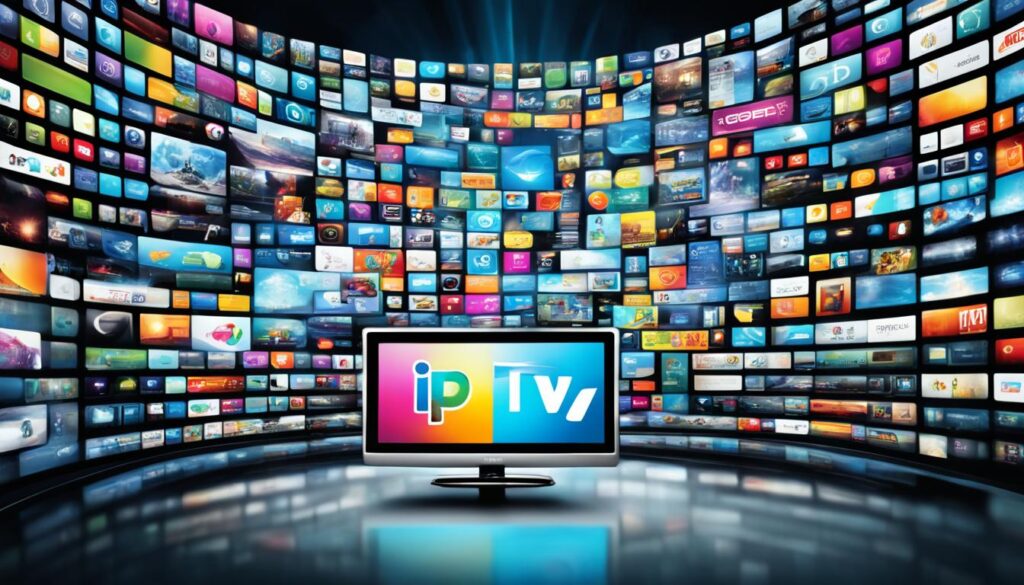
As IPTV grows, providers must keep up with quality and reliability. They face competition and changing content needs. To succeed, IPTV must keep up with technology and what viewers want6.
Personalized News Broadcasts with IPTV
IPTV has changed how we get news, using tech to give us news that fits what we like. This new way lets viewers get updates in real-time, keeping them in the loop with the latest news.
Real-Time Information Access
With IPTV, users get instant access to news from many sources. Channels like BBC World News, CNN International, and Bloomberg TV cover global events19. The growth of IPTV users comes from its engaging and tailored viewing experience20. IPTV also offers video-on-demand and electronic program guides, making news more interactive.
Interactive News Stories
Interactive news makes watching news more fun with graphics, polls, and quizzes19. IPTV lets viewers catch up on missed shows and record live broadcasts20. As tech gets better, we’ll see more augmented and virtual reality in news, making it even more personal19.
The Future of IPTV
The Future of IPTV is all about new tech that makes watching TV more fun and personal. We’re seeing cool stuff like augmented reality (AR) and virtual reality (VR) that let viewers dive into their favorite shows. Thanks to better data analysis, IPTV can now suggest shows that really match what you like to watch2122.
Now, you can watch TV on many devices like smart TVs, tablets, and phones22. You can also pause, rewind, or fast-forward live TV, making it easier to watch what you want, when you want21.
With cloud-based IPTV, you can watch your favorite shows from anywhere, without needing special equipment. This means you can enjoy TV anytime, anywhere, which is super convenient21.
Interactive features are also changing the game, making TV more engaging. You can chat live with others and share on social media, making watching TV a two-way street22.
In short, the Future of IPTV is all about making TV better for viewers. It’s about using new tech to give us the best TV experiences possible.
Challenges Facing IPTV Adoption
The IPTV world is changing fast, but it still faces big challenges. These issues affect how widely IPTV is used. Even though the IPTV market is growing fast, solving these problems is key for success. Knowing about network limitations and connectivity issues can make things better for everyone.
Network Limitations and Connectivity Issues
One big problem is the need for strong networks. The IPTV market is expected to grow a lot, reaching USD 276.38 billion by 203223. But, it needs good networks to work well. If networks are weak, users might see buffering or interruptions, which can ruin the fun.
IPTV can offer amazing quality, like 4K and HDR24. But, it needs strong networks to keep up. As more people want better streaming, the networks must get better too24.
A table shows how bandwidth affects IPTV quality:
| Bandwidth (Mbps) | Streaming Quality | Recommended Usage |
|---|---|---|
| 3-4 | Standard Definition (SD) | Single user |
| 5-8 | High Definition (HD) | Single user |
| 25+ | Ultra High Definition (UHD/4K) | Multiple users |
To fix connectivity issues, IPTV providers need to grow and adapt. They must tackle the challenges of different content and providers24. For IPTV to become more popular, technology and infrastructure must improve. This will help users enjoy IPTV without problems.
Choosing the Right IPTV Provider
Finding the right IPTV provider is key for a great viewing experience. Many things matter when picking an IPTV service. Start by looking at the content they offer. Providers like Smart IPTV and TobigoTv have over 16,000 live TV channels at various prices, appealing to many viewers25.
Prices vary, with Liveplayer IPTV starting at $19 a month or $128 for two years. IPTV Holiday and Sync IPTV offer cheaper options, from $9.98 to $15.99 a month25. Look for providers with flexible plans and easy cancellation to fit your needs, making your experience better.
Good customer service is also key in your IPTV comparison. Having reliable support is a big plus if you run into problems. Check out reviews and feedback on customer service for Best IPTV and Viking IPTV, known for their great support26.
Think about how well the service works with your devices and its ease of use. Many IPTV services work on various devices, including Smart TVs and set-top boxes. Being able to easily use the service and enjoy smooth streaming is crucial for a good experience26.
As IPTV becomes more popular worldwide, considering these points will help you pick the best IPTV service for your needs.

StreamUtopia.com: Your IPTV Solution
StreamUtopia.com is a top choice for IPTV, changing how we watch content. It offers Flexible IPTV packages for all types of viewers. You can pick what you want to watch without paying for extra stuff you don’t need. This lets you save money and enjoy your favorite shows2.
IPTV is changing TV, making it more personal. Now, you can watch what you like, when you like. You can use many devices to watch StreamUtopia.com, so you can watch anywhere, anytime27.
The IPTV market is growing fast, expected to increase by 15.1% from 2023 to 203227. This means more people want reliable IPTV services. StreamUtopia.com offers a wide range of shows and movies. You can watch Live TV, Video on Demand (VOD), or Time-Shifted TV, showing its flexibility27.
If you want a modern way to watch TV, check out StreamUtopia.com. It combines new technology with easy use. With some research and smart choices, you can make this IPTV part of your fun, getting great value and satisfaction27.
Conclusion
IPTV is changing the way we watch TV by offering many benefits over old cable services. It has competitive prices and lets viewers pay for only the channels they like. This means they can save money on their entertainment bills28. IPTV also gives access to lots of local and international channels. Viewers can pick what they want to watch and enjoy shows in high-definition or even 4K with little waiting time29.
IPTV is not just an option; it’s a smart choice for the Future of television. It offers interactive features like video-on-demand and personalized content libraries. These features are becoming key parts of how we watch TV today. IPTV is adapting to what viewers want, making it a strong contender to replace old TV methods that don’t offer much flexibility or personal touch.
As people look for more variety and easy-to-use interfaces, moving to IPTV is becoming a must. It makes watching TV better and fits what viewers want in terms of control and choosing their content. This move is setting the stage for a smarter, more interactive TV future2829.
FAQ
What is IPTV and how does it work?
How does IPTV enhance my television experience?
What are the main benefits of using IPTV?
What interactive features does IPTV offer?
How can I choose the right IPTV provider?
What are the challenges facing IPTV adoption?
How does IPTV integrate with gaming and apps?
What is the future of IPTV technology?
How does IPTV differ from other streaming technologies?
Where can I find great IPTV services?
